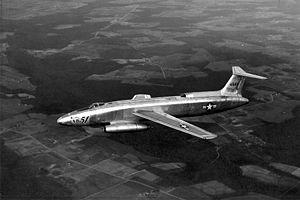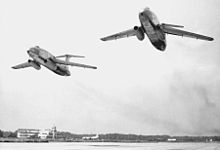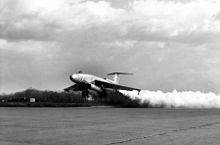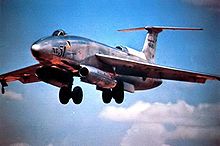Martin XB-51 Video - Overview
|
|
Martin XB-51
XB-51

Picture - First prototype, 46-685 during testing
Role: Bomber
Manufacturer: Glenn L. Martin Company
First flight: 28 October 1949
Retired: 25 March 1956
Status: Cancelled in 1952
Primary user: USAF (NACA)
Number built: 2
Unit cost: US$12.6 million for the program
The Martin XB-51 was an American "tri-jet" ground attack aircraft designed to a 1945 United States Army Air Forces requirement. It was originally designed as an attack aircraft by the Air Force under specification V-8237-1 and was designated XA-45. The "A" ground attack classification was eliminated the next year, and the XB-51 designation was assigned instead. The requirement was for low-level bombing and close support.
The XB-51 lost out in evaluation to the English Electric Canberra which entered service as the B-57.
Design and development

Picture - Both prototypes taking off in formation
The resulting unorthodox design, first flying on 28 October 1949, was (unusually for a combat aircraft) fitted with three engines, General Electric J47s in this case: one at the extreme tail with an intake at the base of the tailfin, and two underneath the forward fuselage in pods. The innovative wings, swept at 35° and with 6° anhedral, were equipped with variable incidence, leading-edge slots, full-width flaps and spoilers instead of ailerons. The combination of variable incidence adjustment and slotted flaps allowed for a shorter takeoff run. Four 954 lb (4.24 kN) thrust Rocket-Assisted Take Off (RATO) bottles with a 14-second burn duration could be fitted to the rear fuselage to further improve takeoff performance. Spectacular launches were a feature of later test flights.

Picture - Testing RATO
The main landing gear consisted of dual sets of wheels in tandem in the fuselage, similar to the B-47 Stratojet, with outrigger wheels at the wingtips (originally proved on a modified B-26 Marauder named "Middle River Stump Jumper"). The B-51 was a large but aerodynamically "clean" design which incorporated nearly all major systems internally. The aircraft was fitted with a rotating bomb bay, a Martin trademark; bombs could also be carried externally up to a maximum load of 10,400 lb (4,700 kg), although the specified basic mission only required a 4,000 lb (1,814 kg) bombload. Eight 20 mm (.79 in) cannons mounted in the nose would have been installed in production aircraft.
Crew provision was for a pilot under a "fighter"-type bubble canopy and a SHORAN (short-range navigation and bombing system) operator/navigator in a compartment located lower than and to the rear of the cockpit (only a small observation window was provided). Both crew members were provided with a pressurized, air-conditioned environment, equipped with upward-firing ejection seats. The XB-51 was the first Martin aircraft equipped with ejection seats; the ejection seats being of their own design.
Operational history

Picture - A screen image from Toward the Unknown
In 1950, the United States Air Force issued a new requirement based on early Korean war experience for a night intruder/bomber to replace the A-26 Invader. The XB-51 was entered, as well as the Avro Canada CF-100 and the English Electric Canberra. The Canberra and XB-51 emerged as the favorites. The XB-51 was a highly maneuverable aircraft at low level, and substantially faster than the Canberra (its "turn-of-speed" was faster than most fighter aircraft of the era). However, its load limiting factor of only 3.67 g (36 m/s) restricted tight turns, and the XB-51's endurance was substantially poorer than the Canberra's; this latter proved to be the deciding factor. Additionally, the tandem main gear plus outriggers of the XB-51 was thought unsuitable for the requirement to fly from emergency forward airfields.
The Canberra was selected for procurement and the XB-51 program ended. Martin did not end up the loser, however, for they were selected to build the 250 Canberras ordered under the designation B-57A. Furthermore, the rotating bomb bay was incorporated in the B-57. A proposed B-57 Super-Canberra also included XB-51 features, such as swept wing and tailplane. In the end it was never built, mainly because it was a new design and would have taken too long to put in production, although it promised much better speed and performance.
Flight testing for research purposes continued after program cancellation. The second prototype, 46-686, which first flew in 1950, crashed on 9 May 1952 during low-level aerobatics. The first prototype, 46-685 continued to fly, including appearing in the film Toward the Unknown as the "Gilbert fighter", then continuing its aerodynamic and weapons-handling tests until it crashed during takeoff on 25 March 1956.
Specifications (XB-51)
General characteristics
Crew: 2
Length: 85 ft 1 in (25.9 m)
Wingspan: 53 ft 1 in (16.2 m)
Height: 17 ft 4 in (5.3 m)
Wing area: 548 ft² (50.9 m²)
Empty weight: 29,584 lb (13,419 kg)
Loaded weight: 55,923 lb (25,366 kg)
Max takeoff weight: 62,457 lb (28,330 kg)
Powerplant: 3x— General Electric J47-GE-13 turbojets
Performance
Maximum speed: 645 mph (1,040 km/h)
Range: 1,075 mi (1,730 km)
Ferry range: 1,613 mi (2,596 km)
Service ceiling: 40,500 ft (12,300 m)
Rate of climb: 6,980 ft/min (35.5 m/s)
Wing loading: 102 lb/ft² (498 kg/m²)
Thrust/weight: 0.28
Armament
Guns: 8 x— 20 mm (0.79 in) cannon with 1,280 rounds
Rockets: 8 x— High Velocity Aerial Rockets (HVAR)
Bombs: 2,000 (907 kg)
Comparable aircraft
English Electric Canberra
Bibliography
Andrade, John M. U.S. Military Aircraft Designations and Serials since 1909. Earl Shilton, Leicester, UK: Midland Counties Publications, 1979. ISBN 0-904597-22-9.
Boyne, Walter. "Attack, The Story of the XB-51, Martin's Phantom Strike Ship!" Airpower, Volume 8, No. 4, July 1978.
Jones, Lloyd S. U.S. Bombers, B-1 1928 to B-1 1980s. Fallbrook, CA: Aero Publishers, 1962, second edition 1974. ISBN 0-8168-9126-5.
Winchester, Jim. "Martin XB-51." Concept Aircraft: Prototypes, X-Planes and Experimental Aircraft. Kent, UK: Grange Books plc., 2005. ISBN 1-84013-309-2.
Robert C. Mikesh. "B-57 Canberra At War 1964-1972". London, UK: Ian Allan, 1980 ISBN 0-7110-1004-8
Martin XB-51 Pictures and Martin XB-51 for Sale.
Living Warbirds: The best warbirds DVD series.
Source: WikiPedia